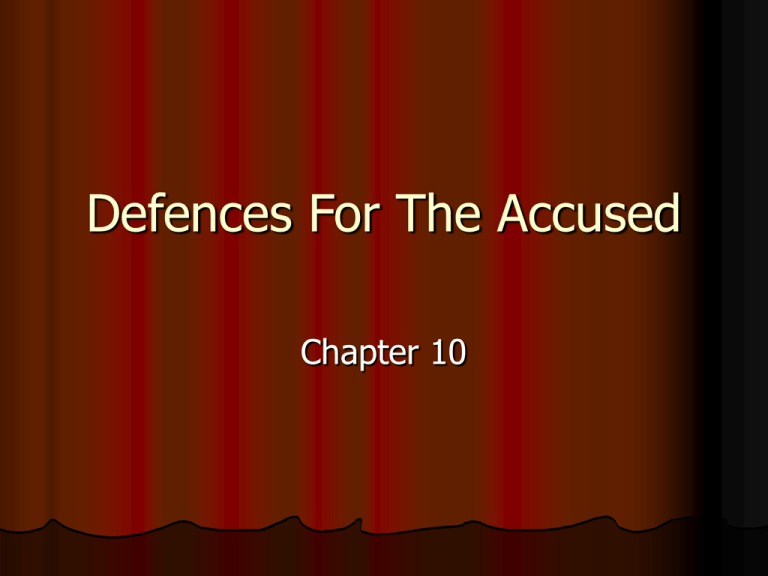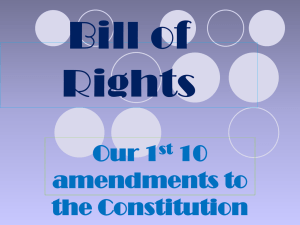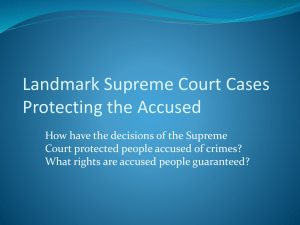Defences For The Accused
advertisement

Defences For The Accused Chapter 10 What is a Defence? A defence is a denial of, or a justification for, criminal behavior. The most common defence is denial! In other situations an accused may admit to the crime but has a defence to excuse or justify his or her actions. The accused can either be acquitted or found guilty of a less serious offence. The following slides present some of the defences an accused can use…………. Mental Disorder 1. 2. Defined in the criminal code as a “disease of the mind”, it was formally referred to as the insanity defence. Goes to mens rea, that is, the accused is unable to form the elements of the “guilty mind”. The onus is on the defence to prove, on the balance of probabilities, that the accused suffered from a mental disorder and fulfilled one of these two requirements: The accused is incapable of appreciating the nature and quality of the act. The accused is incapable of knowing that the act or omission was wrong. If the accused is not criminally responsible the judge can “make an order”, with three choices available: an absolute discharge, a conditional discharge or a term in a psychiatric hospital. The judge may also refer the case to the Criminal code review board, who would hold a hearing to decide the course of action for the accused. The board has the same three choices as the judge, with one key difference. If they send the accused to a psychiatric hospital, it will be for an indefinite period of time, with regular reviews. If the board is convinced that the accused has been cured, they can order a release. That is why this defence is only used in serious cases, because the time spent in a mental hospital could be longer than a jail term. An accused is unfit to stand trial if they are unable to understand the nature of the trial proceedings, the consequences of the proceedings or are unable to give adequate instructions to counsel. Automatism This is a condition in which a person acts without being aware of what he or she is doing. It negates the Actus Reus of a crime because the person acts involuntarily. Automatism can be the result of sleepwalking, medication, a concussion, a brain tumor or involuntary ingestion of drugs. The law recognizes two types of automatism: insane automatism, a form caused by a mental disorder, resulting in an accused being not criminally responsible, and non-insane automatism, a form caused by a external factor. Here the accused would be acquitted. Kenneth James Parks In 1987, Kenneth James Parks got into his car, drove to the home of his wife's parents and brutally attacked the couple, killing his mother-in-law with a tire iron and severely injuring his father-in-law. He then got back in his car and drove to the nearest police station to confess his crime. He claimed he had been asleep throughout the entire incident. Possible? Could a man not only commit murder, but drive his car -- twice -- while asleep? He was acquitted of first and second degree murder by a jury, using the defence of non-insane automatism. Intoxication Intoxication is the condition of being overpowered by drugs or alcohol to the point of losing self-control. It is not generally a defence to a crime but the exception is a crime of specific intent. For example, a person may be too intoxicated for the specific intent of murder, but would still be guilty of manslaughter, a general intent offence. Another exception might be someone so intoxicated that it amounts to a mental disorder. However, this defence is rarely used and cannot be used in cases of assault or sexual assault. This defence can never be used for drinking and driving. Self-Defence Self-defence is the use of reasonable force to defend against an attack, provided the attack was unprovoked and the force used was no more than is necessary to defend yourself. If you kill someone while defending yourself, it is justified only if you reasonably feared that you would be killed or seriously harmed. Battered Woman Syndrome A type of self-defence where the prolonged effects of spousal abuse led to the abusive spouse being killed by the victim. The Supreme Court of Canada found that the jury should be instructed in such cases on three elements. 1. Why an abused woman might stay in an abusive relationship 2. The nature and extent of the violence that may exist in the battering relationship 3. The defendant’s ability to perceive danger from her abuser The syndrome is not a defence in itself. It is a psychiatric explanation for the state of mind of an abused woman, which can therefore be used to justify self-defence. Defence of a Dwelling This is the extension of self-defence to a dwelling house. A dwelling house is any building or other structure that is occupied on a permanent or temporary basis. A person is allowed to defend his or her dwelling from unlawful entry and to remove a trespasser if he or she has entered. The force used must be reasonable under the circumstances. Necessity 1. 2. 3. Necessity is a defence used when the accused had no reasonable alternative to committing an illegal act. For this defence to succeed, all of the following conditions must be met……. The accused must show that the act was done to avoid a greater harm There was no reasonable opportunity for an alternative course of action The harm inflicted must be less than the harm avoided. Compulsion or Duress An accused may be excused from committing an offence if it was done under compulsion or duress, that is, the accused person is forced by the threat of violence to commit a criminal act against his or her will. It is not a defence in violent crimes! Provocation Any act or insult that causes a reasonable person to lose self-control. This defence only applies to murder. To be successfully used, the defence must prove all four of these elements…. 1. A wrongful act or insult occurred 2. This act or insult was sufficient to deprive an ordinary person of the power of self-control 3. The person responded suddenly 4. The person responded before there was time for passion to cool. It is used to reduce murder to manslaughter. (R vs. Stone) Mistakes of Law and Fact A mistake of law is simply ignorance of the law and generally can not be used as a defence. The one exception is officially induced error, a defence that the accused relied on erroneous legal advice from an official responsible for enforcing a particular law. A mistake of fact is a defence that the accused made an honest mistake that led to the breaking of the law. The accused would not have the mens rea or guilty mind. Double Jeopardy The legal doctrine that an accused person cannot be tried twice for the same offence. Holds true, whether the accused has been convicted or acquitted. The only exception is if the Crown appeals based on a mistake of law, and the appeals court orders a new trial or change in sentence. Alibi A defence raised by the accused claiming that he or she was somewhere else when the offence was committed. The burden is on the crown, not the accused! If the crown can’t prove that the accused was there when the offence was committed, then the accused must be acquitted. Entrapment A defence against police conduct that illegally induces the defendant to commit a criminal act. The burden is on the accused to prove entrapment. Usually the result of police undercover work. The police can present an opportunity to commit a crime but cannot harass, bribe or induce a person to break the law. If the judge agrees to this defence, the judge will “stay” the proceedings or stop the trial.







